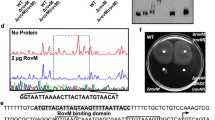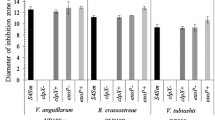Abstract
Sialic acid and its catabolism are involved in bacterial pathogenicity. N-acetylneuraminate lyase (NAL), which catalyzes the reversible aldol cleavage of sialic acid to form N-acetyl-D-mannosamine in the first step of sialic acid degradation, has been recently investigated to elucidate whether NAL enhances bacterial virulence; however, the role of NAL in bacterial pathogenicity remains unclear. In the present study, we demonstrated that the existence of two enzymes in Edwardsiella piscicida, referred to as dihydrodipicolinate synthase (DHDPS) and NAL, induced the cleavage/condensation activity toward sialic acids such as N-acetylneuraminic acid, N-glycolylneuraminic acid and 3-deoxy-D-glycero-D-galacto-non-2-ulopyranosonic acid. NAL enhanced cellular infection in vitro and suppressed the survival rate in zebrafish larvae in bath-infection in vivo, whereas DHDPS did not. Furthermore, NAL strongly activated the expression of E. piscicida phenotypes such as biofilm formation and motility, whereas DHDPS did not. Besides, the gene expression level of nanK, nanE, and glmU were up-regulated in the NAL-overexpressing strain, along with an increase in the total amount of N-acetylglucosamine.






Similar content being viewed by others
Abbreviations
- DHDPS:
-
Dihydrodipicolinate synthase
- GlcNAc:
-
N-Acetylglucosamine
- KDN:
-
3-Deoxy-D-glycero-D-galacto-non-2-ulopyranosonic acid
- Man:
-
Mannose
- ManNAc:
-
N-Acetylmannosamine
- NAL:
-
N-Acetylneuraminate lyase
- Neu5Ac:
-
N-Acetylneuraminic acid
- Neu5Gc:
-
N-Glycolylneuraminic acid
References
Abayneh, T., Colquhoun, D.J., Sørum, H.: Edwardsiella piscicida sp. nov., a novel species pathogenic to fish. J. Appl. Microbiol. 114, 644–654 (2013). https://doi.org/10.1111/jam.12080
Buján, N., Toranzo, A.E., Magariños, B.: Edwardsiella piscicida: a significant bacterial pathogen of cultured fish. Dis. Aquat. Org. 131, 59–71 (2018). https://doi.org/10.3354/dao03281
Mohanty, B.R., Sahoo, P.K.: Edwardsiellosis in fish: a brief review. J. Biosci. 32, 1331–1344 (2007). https://doi.org/10.1007/s12038-007-0143-8
Nikapitiya, C., Chandrarathna, H.P.S.U., Dananjaya, S.H.S., De Zoysa, M., Lee, J.: Isolation and characterization of phage (ETP-1) specific to multidrug resistant pathogenic Edwardsiella tarda and its in vivo biocontrol efficacy in zebrafish (Danio rerio). Biologicals. 63, 14–23 (2020). https://doi.org/10.1016/j.biologicals.2019.12.006
Hu, T., Chen, R., Zhang, L., Wang, Z., Yang, D., Zhang, Y., Liu, X., Liu, Q.: Balanced role of T3SS and T6SS in contribution to the full virulence of Edwardsiella piscicida. Fish Shellfish Immunol. 93, 871–878 (2019). https://doi.org/10.1016/j.fsi.2019.08.014
Li, D.Y., Liu, Y.L., Liao, X.J., He, T.T., Sun, S.S., Nie, P., Xie, H.X.: Identification and characterization of EvpQ, a novel T6SS effector encoded on a mobile genetic element in Edwardsiella piscicida. Front. Microbiol. 12, 643498 (2021). https://doi.org/10.3389/fmicb.2021.643498
Qin, L., Wang, X., Gao, Y., Bi, K., Wang, W.: Roles of EvpP in Edwardsiella piscicida-macrophage interactions. Front. Cell. Infect. Microbiol. 10, 53 (2020). https://doi.org/10.3389/fcimb.2020.00053
Xu, T., Su, Y., Xu, Y., He, Y., Wang, B., Dong, X., Li, Y., Zhang, X.H.: Mutations of flagellar genes fliC12, fliA and flhDC of Edwardsiella tarda attenuated bacterial motility, biofilm formation and virulence to fish. J. Appl. Microbiol. 116, 236–244 (2014). https://doi.org/10.1111/jam.12357
Xie, J., Zhao, Q., Huang, H., Fang, Z., Hu, Y.: Edwardsiella piscicida HigB: A type II toxin that is essential to oxidative resistance, biofilm formation, serum survival, intracellular propagation, and host infection. Aquaculture 535, 736382 (2021). https://doi.org/10.1016/j.aquaculture.2021.736382
Zhang, X., Yan, M., Mu, C., Wu, J., Chen, J., Pan, G., Wang, X.: FucP promotes the pathogenicity of Edwardsiella piscicida to infect zebrafish. Aquac. Reports. 20, 100665 (2021). https://doi.org/10.1016/j.aqrep.2021.100665
Chen, J., Mu, C., Ye, T., Sun, Y., Luo, Q., Wang, X.: The UhpA mutant of Edwardsiella piscicida enhanced its motility and the colonization in the intestine of tilapia. Fish Shellfish Immunol. 104, 587–591 (2020). https://doi.org/10.1016/j.fsi.2020.05.065
Ye, T., Mu, C., Chen, J., Pan, G., Wang, X.: The role of UhpA in regulating the virulence gene expression in Edwardsiella piscicida. J. Fish Dis. 44, 585–590 (2021). https://doi.org/10.1111/jfd.13298
Severi, E., Hood, D.W., Thomas, G.H., Severi, E., Hood, D.W., Thomas, G.H.: Sialic acid utilization by bacterial pathogens. Microbiology 153, 2817–2822 (2007). https://doi.org/10.1099/mic.0.2007/009480-0
Haines-Menges, B.L., Whitaker, W.B., Lubin, J.B., Boyd, E.F.: Host sialic acids: A delicacy for the pathogen with discerning taste. In: Conway, T., Cohen, P. (eds.) Metabolism and Bacterial Pathogenesis, pp. 321–342. Wiley, NJ (2015). https://doi.org/10.1128/9781555818883.ch15
Vimr, E.R., Kalivoda, K.A., Deszo, E.L., Steenbergen, S.M.: Diversity of microbial sialic acid metabolism. Microbiol. Mol. Biol. Rev. 68, 132–153 (2004). https://doi.org/10.1128/mmbr.68.1.132-153.2004
Kahya, H.F., Andrew, P.W., Yesilkaya, H.: Deacetylation of sialic acid by esterases potentiates pneumococcal neuraminidase activity for mucin utilization, colonization and virulence. PLoS Pathog. 13, e1006263 (2017). https://doi.org/10.1371/journal.ppat.1006263
Jin, R. Hu, Y. Sun, B. Zhang, X. Sun, L.: Edwardsiella tarda sialidase: Pathogenicity involvement and vaccine potential. Fish Shellfish Immunol. 33, 514–521 (2012). https://doi.org/10.1016/j.fsi.2012.06.002
Chigwechokha, P.K., Tabata, M., Shinyoshi, S., Oishi, K., Araki, K., Komatsu, M., Itakura, T., Shiozaki, K.: Recombinant sialidase NanA (rNanA) cleaves α2-3 linked sialic acid of host cell surface N-linked glycoprotein to promote Edwardsiella tarda infection. Fish Shellfish Immunol. 47, 34–45 (2015). https://doi.org/10.1016/j.fsi.2015.08.015
Vo, L.K., Tsuzuki, T., Kamada-Futagami, Y., Chigwechokha, P.K., Honda, A., Oishi, K., Komatsu, M., Shiozaki, K.: Desialylation by Edwardsiella tarda is the initial step in the regulation of its invasiveness. Biochem. J. 476, 3183–3196 (2019). https://doi.org/10.1042/BCJ20190367
Gurung, M.K., Altermark, B., Helland, R., Smalås, A.O., Ræder, I.L.U.: Features and structure of a cold active N-acetylneuraminate lyase. PLoS One. 14, e0217713 (2019). https://doi.org/10.1371/journal.pone.0217713
Di Pasquale, P., Caterino, M., Di Somma, A., Squillace, M., Rossi, E., Landini, P., Iebba, V., Schippa, S., Papa, R., Selan, L., Artini, M., Palamara, A.T., Duilio, A.: Exposure of E. coli to DNA-methylating agents impairs biofilm formation and invasion of eukaryotic cells via down regulation of the N-acetylneuraminate lyase NanA. Front. Microbiol. 7, 147 (2016). https://doi.org/10.3389/fmicb.2016.00147
Wang, S.L., Li, Y.L., Han, Z., Chen, X., Chen, Q.J., Wang, Y., He, L.S.: Molecular characterization of a novel N-acetylneuraminate lyase from a deep-sea symbiotic mycoplasma. Mar. Drugs. 16, 80 (2018). https://doi.org/10.3390/md16030080
Sánchez-Carrón, G., García-García, M.I., López-Rodríguez, A.B., Jiménez-García, S., Sola-Carvajal, A., García-Carmona, F., Sánchez-Ferrer, A.: Molecular characterization of a novel N-acetylneuraminate lyase from Lactobacillus plantarum WCFS1. Appl. Environ. Microbiol. 77, 2471–2478 (2011). https://doi.org/10.1128/AEM.02927-10
Tripp, V.T., Maza, J.C., Young, D.D.: Development of rapid microwave-mediated and low-temperature bacterial transformations. J. Chem. Biol. 6, 135–140 (2013). https://doi.org/10.1007/s12154-013-0095-4
Rashid, M.H., Kornberg, A.: Inorganic polyphosphate is needed for swimming, swarming, and twitching motilities of Pseudomonas aeruginosa. Proc. Natl. Acad. Sci. U. S. A. 97, 4885–4890 (2000). https://doi.org/10.1073/pnas.060030097
Yasuno, A., Kokubo, K., Kamei, M.: New method for determining the sugar composition of glycoproteins, glycolipids, and oligosaccharides by high-performance liquid chromatography. Biosci. Biotechnol. Biochem. 63, 1353–1359 (1999). https://doi.org/10.1271/bbb.63.1353
Johnston, J.W., Shamsulddin, H., Miller, A.-F., Apicella, M.A.: Sialic acid transport and catabolism are cooperatively regulated by SiaR and CRP in nontypeable Haemophilus influenzae. BMC Microbiol. 10, 240 (2010). https://doi.org/10.1186/1471-2180-10-240
Mostowy, S., Boucontet, L., Mazon Moya, M.J., Sirianni, A., Boudinot, P., Hollinshead, M., Cossart, P., Herbomel, P., Levraud, J.P., Colucci-Guyon, E.: The zebrafish as a new model for the in vivo study of Shigella flexneri interaction with phagocytes and bacterial autophagy. PLoS Pathog. 9, e1003588 (2013). https://doi.org/10.1371/journal.ppat.1003588
Smith, D.R., Price, J.E., Burby, P.E., Blanco, L.P., Chamberlain, J., Chapman, M.R.: The production of curli amyloid fibers is deeply integrated into the biology of Escherichia coli. Biomolecules. 7, 75 (2017). https://doi.org/10.3390/biom7040075
Hwang, J., Kim, B.S., Jang, S.Y., Lim, J.G., You, D.J., Jung, H.S., Oh, T.K., Lee, J.O., Choi, S.H., Kim, M.H.: Structural insights into the regulation of sialic acid catabolism by the Vibrio vulnificus transcriptional repressor NanR. Proc. Natl. Acad. Sci. U. S. A. 110, E2829–E2837 (2013). https://doi.org/10.1073/pnas.1302859110
Joerger, A.C., Mayer, S., Fersht, A.R.: Mimicking natural evolution in vitro: An N-acetylneuraminate lyase mutant with an increased dihydrodipicolinate synthase activity. Proc. Natl. Acad. Sci. U. S. A. 13, 5694–5699 (2003). https://doi.org/10.1073/pnas.0531477100
Lawrence, M.C., Barbosa, J.A.R.G., Smith, B.J., Hall, N.E., Pilling, P.A., Ooi, H.C., Marcuccio, S.M.: Structure and mechanism of a sub-family of enzymes related to N-acetylneuraminate lyase. J. Mol. Biol. 266, 381–399 (1997). https://doi.org/10.1006/jmbi.1996.0769
Karsten, W., Thomas, L.M., Fleming, C., Seabourn, P., Bruxvoort, C., Chooback, L.: Kinetic, spectral, and structural studies of the slow-binding inhibition of the Escherichia coli dihydrodipicolinate synthase by 2, 4-oxo-pentanoic acid. Arch. Biochem. Biophys. 702, 108819 (2021). https://doi.org/10.1016/j.abb.2021.108819
Impey, R.E., Lee, M., Hawkins, D.A., Sutton, J.M., Panjikar, S., Perugini, M.A., Soares da Costa, T.P.: Mis‐annotations of a promising antibiotic target in high‐priority gram‐negative pathogens. FEBS Lett. 594, 1453–1463 (2020). https://doi.org/10.1002/1873-3468.13733
Ji, W., Sun, W., Feng, J., Song, T., Zhang, D., Ouyang, P., Gu, Z., Xie, J.: Characterization of a novel N-acetylneuraminic acid lyase favoring industrial N-acetylneuraminic acid synthesis process. Sci. Rep. 5, 9341 (2015). https://doi.org/10.1038/srep09341
Pélissier, M.C., Sebban-Kreuzer, C., Guerlesquin, F., Brannigan, J.A., Bourne, Y., Vincent, F.: Structural and functional characterization of the Clostridium perfringens N-acetylmannosamine-6-phosphate 2-epimerase essential for the sialic acid salvage pathway. J. Biol. Chem. 289, 35215–35224 (2014). https://doi.org/10.1074/jbc.M114.604272
Brigham, C., Caughlan, R., Gallegos, R., Dallas, M.B., Godoy, V.G., Malamy, M.H.: Sialic acid (N-acetyl neuraminic acid) utilization by Bacteroides fragilis requires a novel N-acetyl mannosamine epimerase. J. Bacteriol. 191, 3629–3638 (2009). https://doi.org/10.1128/JB.00811-08
Kang, J., Gu, P., Wang, Y., Li, Y., Yang, F., Wang, Q., Qi, Q.: Engineering of an N-acetylneuraminic acid synthetic pathway in Escherichia coli. Metab. Eng. 14, 623–629 (2012). https://doi.org/10.1016/j.ymben.2012.09.002
Yan, L., Fu, L., Xia, K., Chen, S., Zhang, F., Dordick, J.S., Linhardt, R.J.: A revised structure for the glycolipid terminus of Escherichia coli K5 heparosan capsular polysaccharide. Biomolecules. 10, 1516 (2020). https://doi.org/10.3390/biom10111516
Zhang, D., Ke, X., Liu, Z., Cao, J., Su, Y., Lu, M., Gao, F., Wang, M., Yi, M., Qin, F.: Capsular polysaccharide of Streptococcus agalactiae is an essential virulence factor for infection in Nile tilapia (Oreochromis niloticus Linn.). J. Fish Dis. 42, 293–302 (2019). https://doi.org/10.1111/jfd.12935
Jeong, H.G., Oh, M.H., Kim, B.S., Lee, M.Y., Han, H.J., Choi, S.H.: The capability of catabolic utilization of N-acetylneuraminic acid, a sialic acid, is essential for Vibrio vulnificus pathogenesis. Infect. Immun. 77, 3209–3217 (2009). https://doi.org/10.1128/IAI.00109-09
Barnhart, M.M., Chapman, M.R.: Curli biogenesis and function. Annu. Rev. Microbiol. 60, 131–147 (2010). https://doi.org/10.1146/annurev.micro.60.080805.142106
Rossi, E., Paroni, M., Landini, P.: Biofilm and motility in response to environmental and host-related signals in Gram negative opportunistic pathogens. J. Appl. Microbiol. 125, 1587–1602 (2018). https://doi.org/10.1111/jam.14089
Acknowledgements
We appreciate the technical assistance and useful discussions of Dr. Taiki Futagami, Yuko Futagami, Dr. Kazuki Oishi, and Dr. Akinobu Honda. The financial support by JSPS KAKENHI Grant Number 19K06223 is gratefully acknowledged.
Author information
Authors and Affiliations
Corresponding author
Ethics declarations
Ethical Approval
This article does not contain any studies with human participants or animals performed by any of the authors.
Conflicts of Interest
The authors have no conflicts of interest to declare.
Additional information
Publisher's Note
Springer Nature remains neutral with regard to jurisdictional claims in published maps and institutional affiliations.
Supplementary Information
Below is the link to the electronic supplementary material.
Rights and permissions
About this article
Cite this article
Vo, L.K., Tran, N.T., Kubo, Y. et al. Enhancement of Edwardsiella piscicida infection, biofilm formation, and motility caused by N-acetylneuraminate lyase. Glycoconj J 39, 429–442 (2022). https://doi.org/10.1007/s10719-022-10045-z
Received:
Revised:
Accepted:
Published:
Issue Date:
DOI: https://doi.org/10.1007/s10719-022-10045-z




